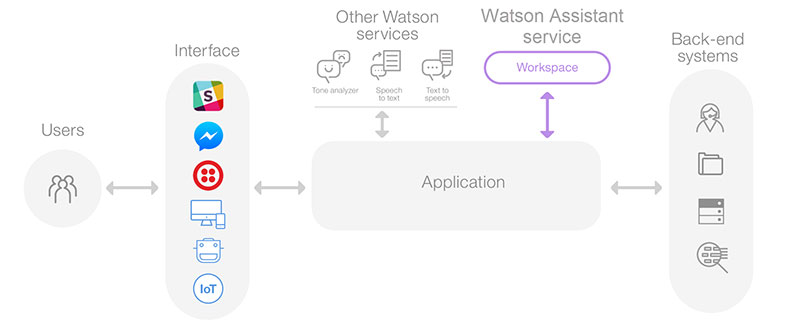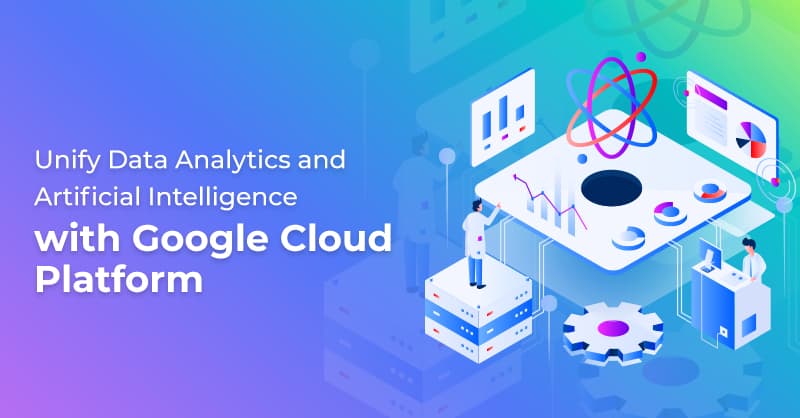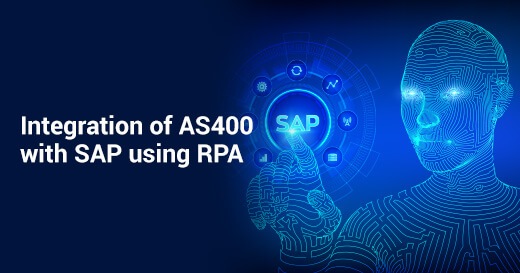IBM Watson Assistant
IBM Watson Assistant formerly Watson Conversation is a service from IBM. It helps to build a solution that understands natural-language and leverage machine learning to reply to customers in a way that is parallel to a conversation between humans.
IBM Watson Assistant Service Solution Architecture

- Users interact with our application through the user interface that we implement. For instance, a simple chat window or a mobile app.
- The application sends the user’s input to the IBM Watson Assistant service.
- The application links to a workspace, which is a holder/case for our dialog flow and training data.
- The service interprets the user’s input, directs the flow of the conversation and gathers information that it needs.
- We can connect additional Watson services to analyze user input, such as Tone Analyzer or Speech to Text.
- The application can engage with our back-end systems based on the user's intent and supplementary information. For example, open tickets, update account information, or place orders.
Implement Conversation
- Configure a workspace.With the easy-to-use graphical environment, we can set up the training data and dialog for the conversation.
- The training data contains the following artifacts:
- Intents: Goals that we anticipate our users will have when they interact with the service. Define one intent for each goal that can be identified in a user's input. For example, we might define an intent named store_hours that answers questions about store hours. For each intent, we add sample words that reflect the input customers might use to ask for the information they need, e.g. what time do you open?
- Entities:An entity represents a term or object that provides context for an intent. For instance, an entity might be a city name that helps your dialog to differentiate which store the user desires to know store hours for.
As we add training data, a natural language classifier is automatically added to the workspace, and is instructed to understand the types of requests that we have indicated the service should listen for and respond to.
Utilize the dialog tool to create a dialog flow that includes our intents and entities. The dialog flow is depicted graphically in the tool as a tree. We can add a branch to process each of the intents that we want the service to handle. We can then add branch nodes that manage the many possible permutations of a request/demand based on factors, such as the entities found in the user input or information that is passed to the service from our application or another external service.
- Deploy the workspace. Deploy the configured workspace to users by connecting it to a front-end user interface, social media, or a messaging channel. The deployed instance of the IBM Watson Assistant service is hosted by IBM Cloud.
IBM Watson Assistant Features
User Friendly Interface
Easy-to-use tooling to build multi-turn dialog and scale quickly.
Pre-built Content
Browse from a list of already configured customer service and industry content packs to save time and start faster.
Analytics & Recommendations
Get insights into conversations and tailor our training of Watson. Understand how users are interacting and how Watson is performing.
Data Privacy
IBM is the only provider that allows us to choose whether our data will be used for improving models. So when we train our model, we can own and protect the insights we have generated.
Use Cases
Banking
A home loans assistant to service Home Loans applicant with their application.
E-Commerce
Watson can help to order and purchase items seamlessly, helping customers to order as quickly and simply as possible.
Hotel
Leveraging IoT, Watson Assistant can set hotel room temperature, offer dining recommendations, turn on lights, and close blinds.
Automotive
IBM Watson Assistant for Automotive can enhance in-vehicle experiences, helping the automotive industry better understand and interact with drivers and passengers. It helps to provide a proactive assistant to predict driver needs and facilitate vehicle functions.
Call Center
A Chatbot that interacts and returns customers support queries instantly 24/7.
Healthcare
IBM Watson Assistant can help accelerate the drug discovery. Even the smartest medical researchers struggle to keep up with the sheer volume of new information being generated. The technology holds immense potential to bring new drugs to market quicker than ever before.
Royal Cyber:
“Bridge the Communication Gap”
Royal Cyber can help you take advantage of the AI advancements and offer a Bot POC in less than 2 weeks.
For more information on our Bot capabilities, check the links provided below:



